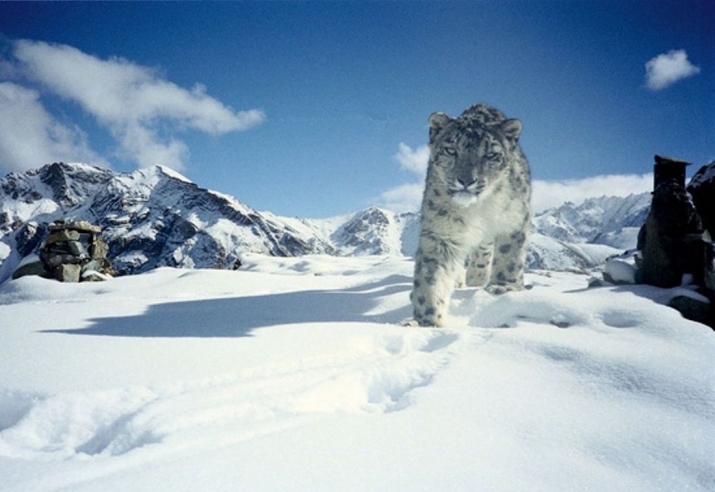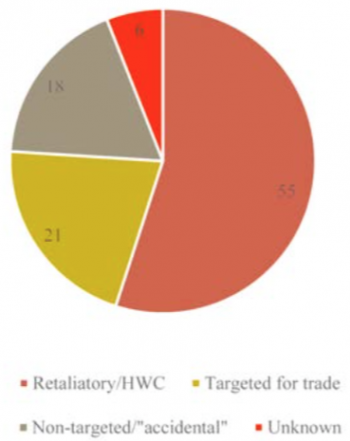NEWS
New Report Shows Snow Leopards Under Grave Threat from Poaching
By Craig Lewis
Buddhistdoor Global
| 2016-10-24 |  A snow leopard in Hemis National Park, India. From wikipedia.org
A snow leopard in Hemis National Park, India. From wikipedia.orgDespite their internationally recognized endangered status,* a recently published report by the wildlife trade monitoring network Traffic suggests that the world’s population of snow leopards is dwindling at an alarming rate at the hands of humans, with as many as 450 snow leopards believed to have been poached annually since 2008. The report estimates that fewer than 4,000 wild snow leopards now remain in the remote mountains of Central Asia.
The notoriously reclusive and highly camouflaged snow leopard, sometimes dubbed the “ghost of the mountains,” is found in remote mountain habitats in 12 countries across the Himalayas and the Tibetan Plateau: Afghanistan, Bhutan, China, India, Kazakhstan, Kyrgyzstan, Mongolia, Nepal, Pakistan, Russia, Tajikistan, and Uzbekistan.
 From traffic.org
From traffic.orgPerhaps surprisingly, Traffic’s research suggests that rather than the illegal wildlife trade, the majority of poaching is the result of retaliatory killings (or human-wildlife conflict [HWC]) by herders and farmers whose livestock is preyed upon by snow leopards. More than 90 per cent of illegal killings occur in China, India, Mongolia, Pakistan, and Tajikistan.
“Based on the average number of cases known to experts over the average of nine years spent working in their geographic areas of knowledge, 221–450 Snow Leopards were estimated to have been poached annually since 2008. With the average rate of poaching detection estimated by experts at less than 38 per cent, these numbers could be substantially higher,” Traffic noted in its report. “Of these, 55 per cent are killed in retaliation for livestock depredation, 21 per cent killed for trade, and 18 per cent taken by non-targeted methods such as snares.” (Traffic)
Examined more closely, the problem of retaliatory poaching becomes somewhat less surprising: the elusive snow leopard is a formidable hunter, able to kill animals three times its weight. Presented with the opportunity to hunt more easily available prey in the form of domesticated animals, one leopard can kill up to 20 goats or sheep enclosed in a pen. Since the majority of the human communities that share the harsh high-altitude habitat of the snow leopard are impoverished, the predation of livestock has a significant impact on livelihoods.
But while the proportion of snow leopards poached for their body parts, such as teeth, claws, bones, and skins, is estimated at only 21 per cent, farmers who kill to protect their livestock may also end up selling the carcass for profit. “Traffic's analysis confirms the worrying scale of illegal killing of snow leopards,” said Traffic’s senior program director, James Compton. “[While] the snow leopard doesn’t turn up that often in markets, what the report authors have concluded is that it’s a bit opportunistic, if a snow leopard is killed and the parts or the pelt is saleable it’s almost like getting your own back for the livestock you've lost.” (Deutsche Welle, BBC)
Although the survival outlook for the reclusive and secretive snow leopard appears bleak, there is at least one ray of hope in Kyrgyzstan, which is believed to be home to some 350 of the cats. In cooperation with the Kyrgyz government, the Snow Leopard Trust and Snow Leopard Foundation have been co-managing the former hunting territory of Shamshy as a wildlife sanctuary since 2015. Experts believe the initiative will help sustain snow leopard numbers as Shamshy is also home to healthy populations of natural prey, such as ibex and mountain goats. By protecting the area from hunting for at least 10 years, animal populations are projected to grow, attracting more snow leopards to the area.
“Kyrgyzstan is like [a] bridge between two large snow leopard ranges, and if we lose snow leopard in this country, then it means the global population will be isolated,” said Kuban Jumabai uulu, director of the Snow Leopard Foundation Kyrgyzstan. “Populations are strong when they are together.” (National Geographic)
With only a quarter of all known cases of poaching properly investigated, the Traffic report is also calling for increased cross-border co-operation, noting that one-third of the snow leopard habitats fall along international borders.
“Even if there is reduced demand for snow leopard skins, the killing will continue unless we all work together to drastically reduce human-wildlife conflict and ensure that mountain communities can co-exist with snow leopards,” said report co-author Rishi Sharma. “Compensation schemes and innovative predator-proof corrals are making a difference, but we urgently need to expand these to benefit communities—and snow leopards—across Asia’s high mountains.” (BBC)
* Snow leopards are listed as endangered on the International Union for the Conservation of Nature (IUCN) Red List of Threatened Species.
See more
An Ounce of Prevention: Snow Leopard Crime Revisited (Traffic)
More Snow Leopards Poached, Even as Bold Plan Fights Decline (National Geographic)
Snow leopards in grave decline, report says (Deutsche Welle)
Snow leopards: Numbers decline due to 'retaliation' (BBC)
Why the world's last few snow leopards are dying at the hands of humans (Christian Science Monitor)
Traffic: the Wildlife Monitoring Network
Related
New Wildlife Reserve Could Help Save China’s Big Cats (Buddhistdoor Global)
Thailand’s “Tiger Temple” Refuses to Surrender Tigers (Buddhistdoor Global)

















